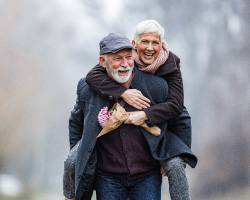
Cold weather can present special challenges for older adults. Among the most dangerous is hypothermia, a potentially fatal drop in body temperature.
Aging bodies are especially vulnerable to hypothermia because they often produce less heat than younger bodies. Normal physical changes also make it more difficult for older people to recognize when their body temperature drops.
According to the National Institute on Aging (NIA), body temperature that is only a few degrees below normal is dangerous. A drop to 95 degrees or below could cause a heart attack, kidney problems, liver damage and more if it persists.
Body temperature of 95 degrees or below is a medical emergency requiring immediate treatment, the Centers for Disease Control and Prevention warns.
Fortunately, these problems can be avoided if you stay alert for signs of hypothermia and know how to stay warm.
Signs of trouble
According to the NIA, early signs of hypothermia are:
- Cold feet and hands.
- A puffy or swollen face.
- Pale skin.
- Lots of shivering.
- Slower-than-normal speech or slurring of words.
- Acting sleepy.
- Being angry or confused.
In later stages, a person with hypothermia may move slowly; have trouble walking; and have stiff, jerky limb movements.
If you think someone has hypothermia, the NIA advises taking the person's temperature and calling 911 if it is at 95 degrees or below.
Until help arrives, cover the person with a warm blanket, towels, a coat or whatever is handy. Warming by rubbing legs or arms, using a heating pad or getting into a bathtub is not recommended.
Reduce your risks
To help prevent hypothermia:
- If you live alone, have someone check on you regularly.
- Ask your doctor if you have any health problems or are taking any medications that might make you more vulnerable to hypothermia.
- Avoid going to cold places or staying outside too long, especially if it's windy.
- Keep up your weight. Fat under your skin can protect your body from cold.
- Avoid alcoholic drinks. They increase loss of body heat.
- Dress for warmth. Wear several layers of loose-fitting clothing. Warm air will be trapped between layers. Wear socks with your shoes and long johns under your clothing (day and night). Wear a cap or hat to bed and add extra covers. When you sit for long periods, put a blanket over your legs.
Heat your house
You've known since childhood that you need to wear a warm coat, boots, a hat, a scarf, and gloves or mittens in the cold outdoors. But you don't have to go outside to develop hypothermia. It can happen indoors too. To stay warm and safe in your home:
- Set your thermostat to 68 degrees or higher. To save on heating bills, close off rooms you're not using, stuff towels in cracks under doors and close draperies or cover windows with blankets at night.
- If you have a power outage, don't stay in a cold house. Go to the home of friends or family.
- If you need help with heating bills, check with a local senior center or agency, or for more information, call the National Energy Assistance Referral Hotline at 866.674.6327.
- Be careful with alternative heating devices. If you use a fireplace, wood stove or kerosene heater, install a smoke detector and a battery-operated carbon monoxide detector near the area to be heated. Test these devices monthly and replace batteries at least once a year. Have a safety inspection of flues and chimneys each year before lighting a fire. If you use a space heater, make sure it's placed at least 3 feet from anything flammable (including carpets) and turn it off before leaving the room or going to sleep. Be aware that older heaters may not meet current safety standards.
Never try to heat your home with a gas stove, charcoal grill or other stove not made for home heating.
Learn more about home fire safety here.
Reviewed 3/25/2024
- Centers for Disease Control and Prevention. "Prevent Hypothermia & Frostbite." https://www.cdc.gov/disasters/winter/staysafe/hypothermia.html.
- Centers for Disease Control and Prevention. "Stay Safe During & After a Winter Storm." https://www.cdc.gov/disasters/winter/duringstorm/indoorsafety.html.
- LIHEAP Clearinghouse. "National Energy Assistance Referral." https://liheapch.acf.hhs.gov/referral.htm.
- National Institute on Aging. "Cold Weather Safety for Older Adults." https://www.nia.nih.gov/health/cold-weather-safety-older-adults.
- U.S. Fire Administration. "Smoke Alarm Outreach Materials." https://www.usfa.fema.gov/prevention/home-fires/prepare-for-fire/smoke-alarms/.